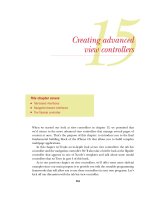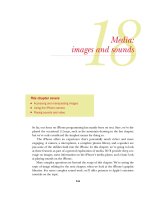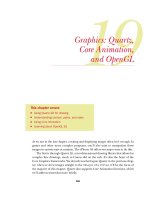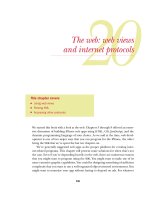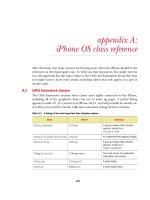Tài liệu Lập trình ứng dụng cho iPhone part 9 doc
Bạn đang xem bản rút gọn của tài liệu. Xem và tải ngay bản đầy đủ của tài liệu tại đây (635.44 KB, 10 trang )
154
SDK programming
for web developers
We’ve spent the last six chapters talking about how to program great web pages and
applications using familiar languages such as
HTML, JavaScript, and PHP; brand-
new libraries such as the WebKit, iUI, and Canvas; and helpful tools such as Dash-
code, Firebug, and Safari. As we discussed in chapter 2, though, web development
isn’t the be-all and end-all of iPhone programming. There are some programs that
will just be better suited for native programming on the iPhone. Apple provides a
development platform for doing this sort of programming called the
SDK (software
development kit). The SDK includes a set of tools, frameworks, and templates that
we’ll meet fully in the next chapter. It also depends on a particular programming
language: Objective-C.
If you’ve never worked with Objective-C, don’t panic. This chapter is intended
to build on your experiences with web development (which we assume includes
This chapter covers
■
Rigorous programming languages
■
Object-oriented programming languages
■
The MVC architectural pattern
155An introduction to C’s concepts
some sort of dynamic programming language, such as PHP, Ruby on Rails, Python, or
Perl) so that you’ll be prepared to work with Objective-C when you encounter it in the
next chapter.
We’ll do this by focusing on three major topics. First we’ll talk about C, which is a
more complex and rigorous programming language than many of the somewhat free-
form web-based languages. It’s also the core of Objective-C. Then we’ll talk about
object-oriented programming, which is the style of programming used by Objective-C.
Finally we’ll hit on
MVC, an architectural model used by many different programming
languages, including Objective-C. If you’re already familiar with some of these con-
cepts, just skip the section where the concept is described.
Before we start this whirlwind tour, we’ll offer one caveat: none of these short over-
views can possibly do justice to the topics. There are complete books on each of these
topics, and if you feel like you need more information, you should pick one up. This
chapter will prepare you so that you will not only understand the code in part 3 of this
book, but will also be ready to dive right in yourself by tweaking and ultimately build-
ing on the copious examples that we’ll provide.
9.1 An introduction to C’s concepts
The syntax of C will look a lot like whatever language you’re familiar with. However, it
may vary from your web language of choice in how it deals with some big-picture
areas, such as declarations, memory management, file structure, and compilation.
We’ve summarized all these ideas in table 9.1, but we’re going to talk about each of
them in turn at more length.
Our goal here isn’t to teach you how to program in C. If you want more informa-
tion on that, the definitive reference is The C Programming Language, Second Edition, by
Brian W. Kernighan and Dennis M. Ritchie (Prentice Hall, 1988). Instead,our goal is
Table 9.1 The rigorous style of C requires you to think about a few new programming topics.
C concept Summary
Declaration and typing You must declare variable types.
You must declare function argument types and return types.
You may need to repeat these declarations in a header file.
Memory management You may sometimes need to explicitly manage the memory usage of your
variables.
Pointers Some variables are represented as pointers to spaces in memory.
File structure Programs are divided between source (.c) and header (.h) files.
Directives Precompiler commands are marked with the # sign. This includes the
#include directive, which incorporates header files into source files.
Compiling Your code is turned into a machine-readable format when you compile it,
not at runtime.
156 CHAPTER 9 SDK programming for web developers
to explain the programming concepts that you may not have encountered in your
web-based programming language.
The reasoning behind this section is ultimately that Objective-C is built right on
top of C. Therefore, we’ll show you how each of these concepts is used in C (though
we’re going to save the guts of Objective-C for the next chapter).
9.1.1 Declarations and typing
C is generally a more rigorous programming language than some of the casual lan-
guages found on the web. That means there’s a bit more time spent saying what you’re
going to do before you do it.
The purpose of this is not only to make it easier for a computer to understand and
efficiently run your program (which was more important in the early 1970s, when C
was first invented, than it is today), but also to make it easier to catch errors (which is
still important today, alas). If you tell the computer what you’re going to do, then it
can give you a warning if that isn’t quite what happens.
First, we see this rigor in the typing of variables. Before you’re allowed to use a vari-
able in C, you must say how it’s going to be used. For example, the following says that
the variable
n
will be used as an integer:
int n;
Second, we see it in functions, where you must declare not only what types of variables
you’ll be passing a function, but also what type of variable you’re going to return. This
is all done as part of the line of code that kicks off the function. For example, the fol-
lowing function takes two floating-point numbers as arguments and returns a floating-
point number:
float divide(float numerator, float divisor) {
These variable and function declarations often get done a second time as part of a
header file, which is a topic that we’ll return to momentarily.
A close relative to type declaration is the idea of type casting. This occurs when you
take a variable and temporarily treat it (“cast it”) as a different type of variable. You do
so by marking the cast in parentheses before the variable that’s being used. It usually
looks something like this:
float a = 6.00;
int b;
b = (int) a;
Here, the float value of
a
is turned into an integer so that it can be saved to the integer
variable
b
. Casting can sometimes lead to unexpected results, so you should be careful
when using it and you shouldn’t do it often.
OBJECTIVE-C DECLARATIONS AND TYPING
Declarations and typing work largely the same way in Objective-C. The only notable
difference is that you’ll more frequently use special Objective-C classes as types than
some of the fundamentals like
int
and
float
.
157An introduction to C’s concepts
Casting comes up the most in Objective-C when you use some of the older frame-
works, such as Core Foundation. Older frameworks tend to have classes for funda-
mental types that aren’t the ones you’d usually use but that are equivalent. For
example, you can freely move between the
CFStringRef
type (from the Core Founda-
tion framework) and the
NSString *
type (from Cocoa’s Foundation framework), but
to avoid compiler warnings and improve clarity, you should cast when doing so.
9.1.2 Memory management and pointers
You didn’t have to worry at all about how memory was used to store your active data in
most web-based languages. Conversely, in C if you’re dynamically changing your data
during your program’s runtime, you often do. Memory management is usually done
in C through the function’s
malloc()
and
free()
methods.
When you specifically allocate memory, you also have to de-allocate it when you’re
done. If you don’t, your program will “leak,” which means that it will gradually
increase its memory footprint over time due to memory that’s been “lost.”
When you allocate memory, you end up working with memory addresses that lead
to your data, rather than the data itself. This is also by default the case with some sorts
of data, such as strings. To address this, C introduces the concept of a pointer, wherein
a variable refers to a memory address rather than to the data itself. When this is the case,
you can dereference the memory address, and thus access your data, with the
*
character.
For example, the following would define a pointer to an integer:
int *bignumber;
Sometimes you need to do the opposite and get a memory address back from a regu-
lar variable. This is done with the
&
symbol:
int variable = 72;
int *variablepointer = &variable;
This symbol is often used to pass error messages back from a function.
OBJECTIVE-C MEMORY MANAGEMENT AND POINTERS
On the iPhone, memory management is vitally important because of the device’s
limited memory. If you’re sloppy with your memory usage, you’ll start receiving
didReceivedMemoryWarning
messages and eventually your program could get shut
down. Objective-C uses the same general concepts of memory allocation and memory
deallocation that we’ve already discussed, but it has some specific rules for when you
have to worry about freeing up memory yourself. Because these rules are based on
functionality of the iPhone
OS, we cover them in the next chapter in section 10.4.2.
Although Objective-C objects are generally built using pointers to memory, you
don’t have to worry about dereferencing them because the details are hidden by the
SDK’s classes. However, when you initially declare objects, you’ll always do so with a
*
;
you’ll constantly be creating pointers to objects.
In addition, you may occasionally run into a library that isn’t built around object-
oriented classes. In that situation you’ll need to make full use of pointers. As you’ll
see, this is the case with
SQLite, which is discussed in chapter 16.
158 CHAPTER 9 SDK programming for web developers
9.1.3 File structure and directives
When you look at the file structure of a complex C program, you’ll see that it includes
a variety of files with .c and .h suffixes. The .c files include all the source code: the var-
ious functions that you’re accustomed to using in a program, split up in a (hopefully)
rational way.
The .h (or header) files, meanwhile, are the tools that allow you to easily integrate
the source code from one .c file into the rest of your program. They contain all the
declarations for variables that you want to make available outside of specific functions.
In addition, they contain function prototypes. These are declarations for your functions
that effectively describe a protocol for using them:
float divide(float numerator, float divisor);
Just as header declarations make a variable available outside its own function, func-
tion prototypes make a function available outside its own file.
To use a header file, you need the capability to include one file inside another. For
example, if you want to access some of the global variables or some of the functions of
file2.c in file1.c, you do so by incorporating file2.c’s header file. You do this by insert-
ing an include command into file1.c:
#include "file2.h"
The appropriate file is then inserted as part of the C preprocessor’s work. This is
what’s known as a compiler directive, or just a macro.
OBJECTIVE-C FILE STRUCTURES AND DIRECTIVES
Objective-C replaces .c files with .m or .mm files and replaces the
#include
directive
with
#import
, but the overall ideas are the same.
9.1.4 Compiling
The final major difference between C and most web-based programming languages is
that you must compile it. This means that the human-readable source code is turned
into machine-readable object code. The same thing happens to your web programs,
but whereas they compile at runtime, C instead compiles in advance, providing for
more efficient program startup at the cost of portability. C compilation can be done
by a command-line program (like “cc” or “gcc”) or by some fancy integrated develop-
ment environment (
IDE).
Because C programs tend to include many files, they need special instructions to
tell the compiler how to put all the code together. This is most frequently done with a
makefile, though integrated environments might have their own ways to list what
should be used, possibly shielding the user entirely from worrying about this.
OBJECTIVE-C COMPILING
All of these details will be taken care of for you by Xcode, Apple’s development envi-
ronment. You therefore don’t have to worry about makefiles or how the compiling
works. The only catch is that you must remember to always add files (such as databases
or images) to your project through Xcode so that they get added in correctly.
159An introduction to object-oriented programming
9.1.5 Other elements
C is full of other features that may or may not have turned up in your programming
language of choice. Among them are symbolic constants (which are permanent decla-
rations, typically used to increase readability), special sorts of loops (such as
while
and
do-while
), older-style branching statements (such as
goto
labels), and some
more complex structures (such as unions).
We can’t cover all of these topics with any justice here, so we’ve held ourselves to
the big-picture stuff. If you see something unfamiliar in Objective-C code that you’ve
been handed, and it looks like it’s a foundational C structure of some sort, we again
point you to Kernighan and Ritchie’s definitive book on the topic.
With C now covered in the depth that we can give it, we’re ready to move on to the
next major element that will define your Objective-C programming experience:
object-oriented programming.
9.2 An introduction to object-oriented programming
C is fundamentally a procedural language, as are early web-based languages like Perl
and
PHP (though that’s changing for both through current releases). You make calls to
functions that do the work of your program. Object-oriented programming (OOP)
moves away from this old paradigm. Specifically, there are no longer separate functions
and variables; instead, data and commands are bound into a more cohesive whole.
As in our previous section, we’ve created a summary chart of the major elements of
object-oriented programming, which you can find in table 9.2.
If you need more information than what we’ve written here, Design Patterns: Elements of
Reusable Object-Oriented Software (Addison-Wesley Professional, 1994) by Erich Gamma,
Richard Helm, Ralph Johnson, and John Vlissides is an influential book that generally
talks about
OOP, then specifically covers some design patterns usable in it. But you
should find all the basics here, starting with a look at the fundamentals of object-
oriented programming.
Table 9.2 Object-oriented programming introduces a number of new concepts.
OOP concept Summary
Class A collection of variables and functions that work together
Framework A collection of class libraries
Inheritance The way in which a subclass gets variables and functions from its parent
Message A call sent to an object, telling it to execute a function
Method A function inside a class, executed by a message
Object A specific instance of a class
Subclass A descendent of a class, with some features in common and some variance
160 CHAPTER 9 SDK programming for web developers
9.2.1 Objects and classes
The central concept in OOP is (as you might guess) the object. Think of it as a super-
variable, or (if you prefer) as a concrete, real-world thing—which is what’s actually
being modeled in the OOP paradigm.
An object combines values (which Objective-C calls instance variables and properties)
and functions (which Objective-C calls methods). These variables and methods are
intrinsically tied together. The variables describe the object while the methods give
ways to act on it (such as creating, modifying, or destroying the object).
Objects are specific instances of classes. The class is where the variable and method
descriptions actually appear. An individual object then takes all of that information,
and starts setting its own version of the variables as it sees fit.
Classes gain power because they support inheritance. That means that you can sub-
class an existing class. Your subclass starts off with all the default variables and meth-
ods for its parent class, but you can now supplement or even override them.
It’s frequent for a subclass to override a parent method by first calling the parent
method, then doing a few things to vary how it works. For example, if you had a class
that represented an eating utensil, it might include a simple method to transfer solid
food from your plate to your mouth. If you created a subclass for a spoon, it could
include a new method that worked on liquids.
Once you’ve created a hierarchy of classes and subclasses, you can store them away
in a class library. When you put several of those together you have a software framework,
and that’s what we’ll be working with in the
SDK, as Apple has provided numerous
frameworks to make your programming of the iPhone easier.
9.2.2 Messaging
If the object is the OOP equivalent of the variable, then the message is the OOP equivalent
of the function. To get something done in an object-oriented program, you send a mes-
sage to a specific object that asks it to execute a specific method. The object then does
so internally, using its own variables and reporting its results out to the calling object.
One of the most frequent types of messages that you’ll see in
OOP is a call to a
method that looks at or changes an object’s variables. A getter is an accessor that looks at
data, while a setter is a mutator that changes data (though Apple calls both accessors in
some of its documentation).
It’s important to use accessors and mutators because they support the core OOP
ideal of encapsulation. The actual variables in objects are hidden away from the rest of
the world, freeing up that global namespace, which otherwise could become quite
cluttered. If one object uses a
foo
variable, that no longer impacts the use of a
foo
variable by another object. Instead, each variable can only be accessed by the methods
of its own class.
Some
OOP languages support two different types of messages. You might see calls
to class methods (where a special class object does general stuff like create an object) or
161The Model-View-Controller (MVC) pattern
to instance methods (where a specific instance object acts in some way). As you’ll see,
this is the case with Objective-C.
Figure 9.1 combines many of the ideas that we’ve talked about so far into a single
diagram using a vegetative example.
When we look at the classes that are built into the iPhone
OS, we’ll see that there are even
more levels of inheritance and overall a much larger web of classes and messages.
That ends our brief overview of object-oriented programming, but there’s one
more high-level abstraction that you should be familiar with before you dive into the
iPhone
SDK: the MVC architectural pattern.
9.3 The Model-View-Controller (MVC) pattern
Programming languages innately have their own philosophies and models that under-
lie how they work. Encapsulation and inheritance are two of the philosophies that are
critical to
OOP. A philosophy that’s critical to good Objective-C programming is the
Model-View-Controller (MVC) architectural pattern.
This method of software design goes back to 1979, when Trygve Reenskaug—then
working on Smalltalk at Xerox
PARC—described it. It’s widely available today in OOP
frameworks, including the iPhone’s Cocoa Touch, and as libraries for other program-
ming languages.
Ur Plant
Methods:
Grow
Photosynthesize
Variables:
Nutrition
Height
Ur Weed
Methods:
Grow Stickler
Variables:
Stickler Type
Ur Tree
Methods:
Grow Fruit
Grow Leaf
Variables:
Fruit Type
Evergreen Boolean
Apple Tree
Methods:
Grow Fruit (Apple)
Variables:
Apple Type
Apple
Tree
#1
Apple
Tree
#2
Ur Fruit
Methods:
Sprout Seeds
Variables:
Seed Count
Sugar Content
Apple
Methods:
Create Fruit
Variables:
Color
Apple
#1
Grow Fruit (Apple)
CLASSESOBJECTS
messaging
inheritance
Figure 9.1 Inheritance and messaging combine to form an intricate network of objects in
object-oriented programming.
162 CHAPTER 9 SDK programming for web developers
The MVC pattern breaks a program into
three parts. The model is the data at the heart
of a program. Meanwhile, the view and the
controller together comprise the presenta-
tion layer of your application. The view is
essentially the user interface side of things,
while the controller sits between the view and
the model, accepting user input and modi-
fying the other elements appropriately. Fig-
ure 9.2 shows what this model looks like.
In figure 9.2 you can see the core ideal of the controller accepting input and mak-
ing changes, but note that there will also be direct interaction between the model and
the view.
Dynamic web design offers a simple example of an
MVC pattern. The model repre-
sents your data, usually stored in a database or
XML. The view is your HTML page
itself. Finally, the controller is your JavaScript, PHP, Perl, or Ruby on Rails code, which
accepts the input, kicking out HTML code on one side and modifying the database on
the other.
Within Objective-C, you’ll see an even more explicit interpretation of
MVC. There
are objects specifically called views and view controllers. If you’re following good
Objective-C programming practice, you’ll make sure your controllers are accepting
input from your view and doing the work themselves.
9.4 Summary
We think it’s entirely possible for someone without object-oriented experience (and
even without C experience) to make the transition from creating iPhone-based web
pages to creating iPhone-based native apps. We’ve already seen it happen at iPhone
development camps. We also think there are good reasons for doing so. As we said
back in chapter 2, the
SDK and web development can each do different things well,
and it’s always best to use the right tool for the job at hand.
We won’t promise that it’ll be easy. The whole idea of objects replacing procedural
calls is a pretty big switch in how you do things when programming. When you meet
actual Objective-C code, you’ll also see that even with the simplest program you’re
going to have several files to work with that each serve very different purposes.
Fortunately you’re going to have four terrific advantages on your side. First, of
course, you’ll have this book to help guide you. Second, you’ll have access to the
SDK’s
programming tools: Xcode and Interface Builder. The first will constantly offer you
whatever documentation you need for the objects, methods, and properties you’re
using, while the second will provide you with a simple, graphical way to create objects.
Third, you’re going to have Objective-C itself on your side. Although its code looks a bit
different from most programming languages you’ve worked with, its code is simple,
Controller
(interaction)
Model
(data)
View
(display)
obtain data
switch
view
set
state
pass
interaction
report changes
Figure 9.2 The MVC model covers how user
input and other changes affect your program’s
design.
163Summary
elegant, and overall quite easy to read. Fourth, you’re going to be able to use the
iPhone OS’s enormous library of frameworks, making your code even shorter and sim-
pler thanks to many years of development on Apple’s part, just as we already saw with
Apple’s Dashcode and web development.
You’re going to be amazed at what you can do in just a few lines of code.
